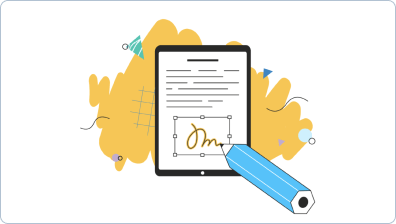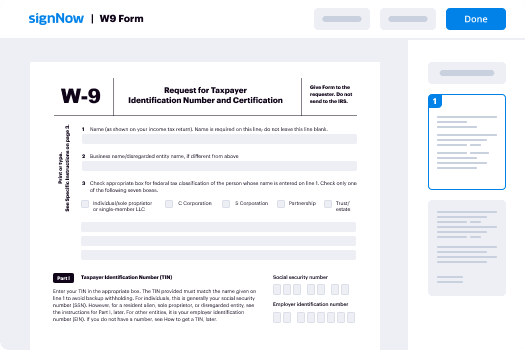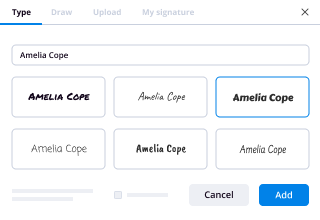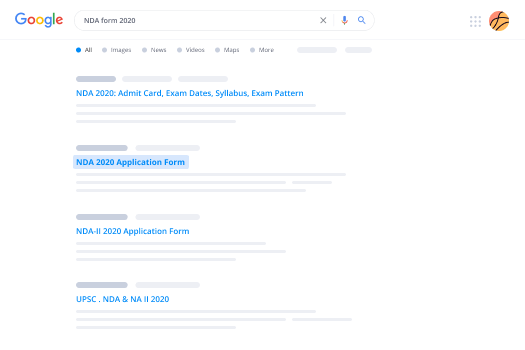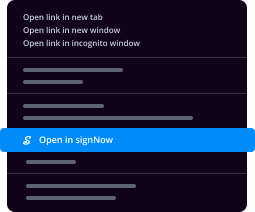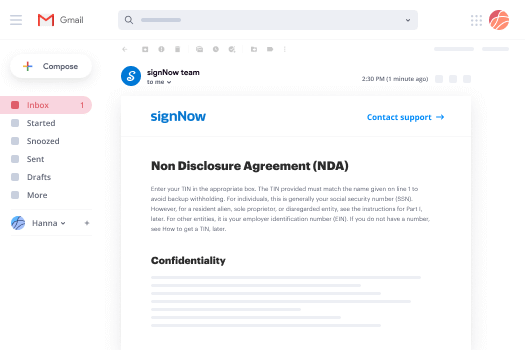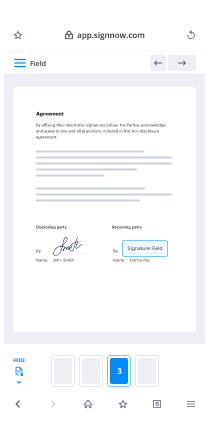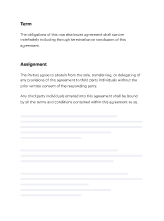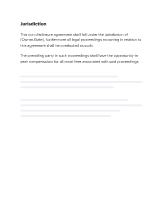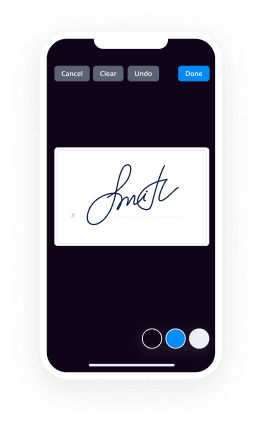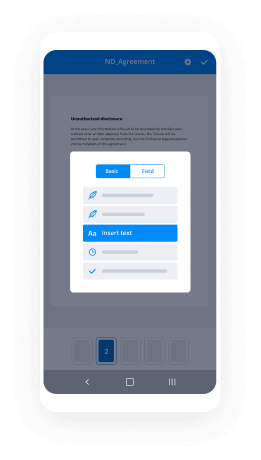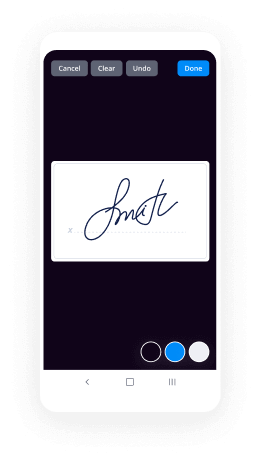Physical Signature
- Quick to start
- Easy-to-use
- 24/7 support
Simplified document journeys for small teams and individuals




We spread the word about digital transformation
Why choose airSlate SignNow
-
Free 7-day trial. Choose the plan you need and try it risk-free.
-
Honest pricing for full-featured plans. airSlate SignNow offers subscription plans with no overages or hidden fees at renewal.
-
Enterprise-grade security. airSlate SignNow helps you comply with global security standards.







6 grounds why airSlate SignNow is a successful solution
Add legally-binding electronic signatures
Generate smart fillable areas
Send paperwork for signing
Follow the status of your forms
Save time by mailing invites in bulk
Physically signed
Your complete how-to guide - physical signature
These days, you probably won't find a company that doesn't use modern day technologies to atomize workflow. A digital signing is not the future, but the present. Present day businesses using their turnover simply don't want to stop online software that provide advanced document processing automation tools, including Electronic signature vs. Physically signed meaning meaning function.
How to fill out and sign a physical signature meaning:
-
Once you get to our website, Login or register your account if you don't have one, it will take you a matter of moments.
-
Upload the appropriate data file or select one from your library folders: Documents, Archive, Templates.
-
As a result of cloud-structured storage compatibility, you can quickly import the needed doc from favored clouds with almost any device.
-
You'll discover your data document opened in the up-to-date PDF Editor where you can add adjustments before you decide to proceed.
-
Type textual content, insert graphics, include annotations or fillable boxes to be finished further.
-
Use My Signature button for self-signing or place Signature Fields to send the eSign require to one or several recipients.
-
Use the DONE button when completed to continue with Electronic signature vs. What is a physical signature function.
airSlate SignNow browser platform is vital to increase the efficiency and performance of most working processes. Electronic signature vs. physical signature is one of the features that can help. Making use of the web-based application nowadays is a necessity, not a competitive edge. Try it now!
How it works
Rate physically signed meaning
What is the physical signature
A physical signature is a handwritten mark or sign made by an individual to signify agreement or acknowledgment on a document. This traditional method of signing involves physically writing one's name on paper, which serves as a legal validation of the signer's intent. While physical signatures have been widely used for centuries, the rise of digital technology has introduced alternative methods, such as electronic signatures, which offer greater convenience and efficiency in document management.
How to use the physical signature
To use a physical signature, an individual must first print the document that requires their signature. After reviewing the content, they can sign the document in the designated area, typically at the bottom or an assigned signature line. Once signed, the document can be scanned or photographed to create a digital copy, which can then be shared via email or other digital platforms. This method ensures that the physical signature is preserved while allowing for easy distribution and storage of the signed document.
Legal use of the physical signature
Physical signatures hold legal significance in the United States, often required for various agreements, contracts, and official documents. The Uniform Commercial Code (UCC) and the Electronic Signatures in Global and National Commerce (ESIGN) Act provide guidelines on the validity of signatures. While physical signatures are legally binding, it is essential to ensure that the signer has the capacity to sign and that the document is executed in compliance with relevant laws. Understanding the legal implications of a physical signature is crucial for maintaining the integrity of agreements.
Steps to complete the physical signature
Completing a physical signature involves several straightforward steps:
- Print the document that requires your signature.
- Read through the document carefully to understand its contents.
- Locate the signature line or designated area for signing.
- Sign your name in the appropriate space using a pen.
- Make sure the signature is clear and legible.
- Optionally, date the document if required.
- Scan or take a photo of the signed document to create a digital version.
Examples of using the physical signature
Physical signatures are commonly used in various scenarios, including:
- Signing contracts for rental agreements or leases.
- Completing tax forms and other government documents.
- Finalizing legal agreements, such as wills or power of attorney documents.
- Authorizing financial transactions, such as checks or loan applications.
- Signing employment contracts and HR-related documents.
Security & Compliance Guidelines
When using physical signatures, it is essential to adhere to security and compliance guidelines to protect sensitive information. Ensure that signed documents are stored securely to prevent unauthorized access. Additionally, consider using secure methods for sharing signed documents, such as encrypted email or secure file transfer services. Compliance with relevant regulations, such as the Health Insurance Portability and Accountability Act (HIPAA) for medical documents, is also crucial to maintain the confidentiality of personal information.
Digital vs. Paper-Based Signing
While physical signatures involve traditional pen-and-paper methods, digital signing offers a modern alternative that enhances efficiency. Digital signatures can be completed electronically, eliminating the need for printing and scanning. They provide benefits such as faster turnaround times, reduced paper usage, and easier storage and retrieval. Understanding the differences between digital and paper-based signing can help individuals and businesses choose the most suitable method for their needs.
-
Best ROI. Our customers achieve an average 7x ROI within the first six months.
-
Scales with your use cases. From SMBs to mid-market, airSlate SignNow delivers results for businesses of all sizes.
-
Intuitive UI and API. Sign and send documents from your apps in minutes.
FAQs physically sign
-
What is a physical signature and how does it differ from an electronic signature?
A physical signature is a handwritten mark made by an individual on a document, typically using a pen. Unlike electronic signatures, which are created digitally, physical signatures require the physical presence of the signer. Understanding the difference is crucial for businesses transitioning to digital solutions like airSlate SignNow.
-
Can I use airSlate SignNow to create a physical signature?
While airSlate SignNow primarily focuses on electronic signatures, you can upload a scanned image of your physical signature to use in your documents. This allows you to maintain a personal touch while benefiting from the efficiency of digital signing. It's a great way to blend traditional and modern signing methods.
-
What are the benefits of using airSlate SignNow over traditional physical signatures?
Using airSlate SignNow offers numerous benefits over traditional physical signatures, including faster turnaround times, reduced paper usage, and enhanced security. With electronic signatures, you can sign documents from anywhere, eliminating the need for physical presence. This streamlines your workflow and saves valuable time.
-
Is airSlate SignNow compliant with legal standards for physical signatures?
Yes, airSlate SignNow complies with all legal standards for electronic signatures, making them as valid as physical signatures in many jurisdictions. This compliance ensures that your signed documents are legally binding and recognized by courts. You can confidently use airSlate SignNow for all your signing needs.
-
What pricing plans does airSlate SignNow offer for businesses needing physical signature solutions?
airSlate SignNow offers flexible pricing plans tailored to meet the needs of businesses of all sizes. Each plan includes features that support both electronic and physical signatures, ensuring you have the tools necessary for efficient document management. Visit our pricing page for detailed information on each plan.
-
Can airSlate SignNow integrate with other software for managing physical signatures?
Absolutely! airSlate SignNow integrates seamlessly with various software applications, enhancing your ability to manage both electronic and physical signatures. This integration allows you to streamline your processes and maintain a cohesive workflow across different platforms. Check our integrations page for a complete list of compatible applications.
-
How secure is my information when using airSlate SignNow for physical signatures?
Security is a top priority at airSlate SignNow. We employ advanced encryption and security protocols to protect your information when using our platform for physical signatures. This ensures that your documents remain confidential and secure throughout the signing process.
Physical signature
Trusted eSignature solution - what is a physical signature
Related searches to physically signed
Join over 28 million airSlate SignNow users
Get more for what is physical signature
- Increase Compliance with eSignatures: power of attorney ...
- Increase Compliance with eSignatures: power of attorney ...
- Increase Compliance with eSignatures: power of attorney ...
- Get Started with eSignature: program to fill out pdf ...
- Transform a PDF into an Interactive Document: secure ...
- Start Your eSignature Journey: sign a pdf on pc
- Increase Compliance with eSignatures: sign ...
- Start Your eSignature Journey: sign document pdf online
The ins and outs of eSignature

